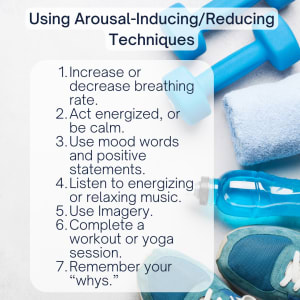
Goal: To bring yourself or someone else to optimal arousal or activated states for optimal performance.
1. Increase or decrease breathing rate.
2. Act energized or be calm.
3. Use mood words and positive statements.
4. Listen to energizing or relaxing music.
5. Use imagery.
6. Complete a workout or yoga session.
7. Remember your "whys".
When we are kids the first things we are taught to help us maintain emotional, mental and physical control is to take a deep breath. Doing so slows the heart rate, relaxes tension in the body and eases racing thoughts and anxiety. After a hard day of work and taking care of various other responsibilities, a person could benefit from slow and deep breathing to ready the body physically and mentally for the workout ahead. The opposite could be said for someone coming in early in the morning before work. If they have not been awake long, they may not be activated to an optimal level for training. Short, deep breaths tend to activate and speed up the nervous system. This accelerated breathing pattern may be more beneficial to get the person primed if they are about to be active.
The next technique is to act energized. Football players may bang against each other's shoulder pads or helmets before games to get pumped up. In our training programs we are encouraged to fire up the peripheral nervous system (PNS) in warm-ups by doing something active like jumping rope or doing wall balls. This way we do not go into a loaded or non-loaded movement pattern without first activating the muscles necessary. As a personal coach, we too can exhibit to our clients certain energizing characteristics with our body language and how we move. On the opposite end, some people may come in already wound tight and need to ease tension before engaging in an exercise program. Myofascial release and static stretching may be more appropriate than more dynamic movements in this case to ready the person's arousal to its optimal level. They may need us as a trainer that day to be more mentally present and calm in our movements.
Going along with the previous technique, what we say to ourselves and our clients can also help regulate arousal levels. The mind certainly affects the body. Saying words like strong, forward, tough, aggressive, move, quick, fast, hard, etc. can be energizing and activating. Using positive statements such as "get tough", "I can do it", or "get going" can also be energizing. On the other hand, we may need to reduce tension and anxiety in ourselves or our clients and so saying words like slow, control, easy, focus, breathe, etc. may be more appropriate. Positive statements will still be necessary, but may be more compassionate rather than aggressive. Statements like "I am glad I made it to my workout today", "this is going to make me feel better", or "I remember why I want to do this and it is important to me" will activate the necessary arousal response for someone who feels lackluster or unmotivated.
The next arousal regulating technique is my personal favorite, listening to music. There are all types and styles of music out there to choose from. Certain songs and styles can be amazing at creating an energetic and positive response. If I am miles into my run and considering stopping and going ho me, I may change my mind if a song comes on that I really like or needed at that time when I am most tired. Music can be a strong factor to reach flow state. Flow is when the body continues to perform optimally and almost effortlessly, time seems to go by and the person is extremely present in the moment and very aware of all of their senses. When the body and mind get fatigued, music can help a person find their second wind so to speak. On the contrary, music can also help an anxious or highly activated person relax. Something with a slower tempo can help people breathe slower and deeper, which in turn calms the parasympathetic nervous system. Someone who is not activated enough, or over activated, may find a difficult time with balance and controlling their movements. Optimal arousal levels will help a person have a strong and stable foundation, thereby optimizing their movement patterns.
Imagery is the next technique that can be used to generate arousal and positive feelings. Let's say you, or your client, are about to get into some heavy deadlifts. Using all of the 5 senses during a quick visualization before getting into it can help with focus and technique. They can see and feel themselves setting up, going through, and completing the movement with good form and strength. A coach or personal trainer may be able to help make this mind-muscle connection deeper by using certain words and tone of voice that trigger the senses. A sprinter can imagine a cheetah running swiftly over the plains, or a swimmer may imagine moving powerfully through the water like a shark. Whether a person is under or over aroused, the imagery technique can help increase or decrease arousal to optimal performing levels. By increasing concentration, risk for injury can be greatly reduced as well.
Another approach to arousal regulation is to be more or less active. This one makes the most sense and has been proven in research time and time again. Almost every time my clients or I workout, we feel better and usually more energized after completing the workout then before we started. A good workout session can prime the body and mind to feel more ready to take on other tasks and responsibilities. That is why many people feel lit is the best way to start off their day. A good workout session can also leave the body and mind feeling more relaxed and provide a sense of accomplishment. An individual who is over-aroused may benefit more from a less intense workout, such as a stretching or yoga session where they can focus on deep breathing and slow controlled movements. On the other hand, an exercise session that is higher in intensity where the body and mind can be more fatigued, like a run, bike ride or heavy lifting session, may also be relaxing and reduce arousal in some people. If the person is looking to induce or reduce energy levels, some form of physical movement can produce regulating benefits. If a person feels they are doing too much, they may benefit more from rest.
The last technique for arousal regulation is to remember why what you're about to do is important to you. Re-establishing a mindset that what you are doing aligns with your values and goals can be very motivating and energizing. It can also help you refrain from engaging in unhealthy behaviors, such as consuming food or beverages that do not align with what you want. Remembering that we want and desire good behaviors to be consistent and nobody is forcing it upon us can help provide a more narrow focus and direction. This also allows obstacles and excuses to go by the wayside and keep you on track in your journey for optimal health and life satisfaction.
All of these techniques can be effective at the appropriate times. Some may work better in certain situations than others. It is good to practice each one of these and use them interchangeably, or even together. Just like anything with practice, they can become more natural and routine over time. When it comes to our goals and bettering ourselves, it is vital that we give ourselves the best chance to get the most out of it. By self-monitoring and self-regulating our energy levels we give ourselves that chance to perform at out best.
Caleb Campbell, M.S., NASM-CPT, BCS, GFS
GoTimeTraining Trainer



